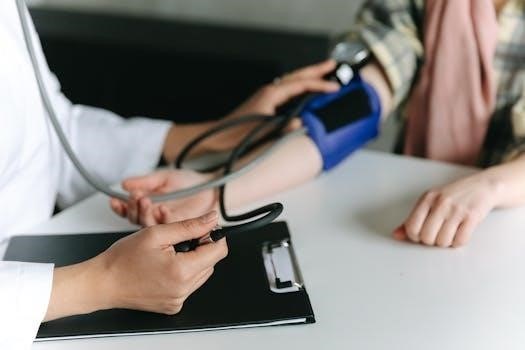Cardiovascular System Overview
The system is a network of the heart, blood vessels, and blood. It delivers oxygen and nutrients while removing waste. The heart acts as a central pump, propelling blood through the body’s intricate network, ensuring efficient circulation.
Basic Components
The system fundamentally consists of the heart, blood vessels, and blood itself. The heart, a muscular organ, acts as the pump, propelling blood through the body. Blood vessels, including arteries, veins, and capillaries, form the network of conduits for blood flow. Arteries carry oxygenated blood away from the heart, while veins return deoxygenated blood to the heart. Capillaries are the smallest vessels, facilitating the exchange of gases, nutrients, and waste products between blood and tissues. The blood, composed of plasma, red blood cells, white blood cells, and platelets, is the medium for transport. Together, these components work in a coordinated fashion to ensure the effective circulation and delivery of essential substances throughout the body, maintaining its overall function. The proper functioning of each of these components is critical for overall health.
Heart as a Pump
The heart serves as the central pump of the system, driving blood circulation throughout the body. It is a muscular organ located in the chest, responsible for generating the pressure needed to propel blood through the arteries, veins, and capillaries. The heart functions as two synchronized pumps⁚ the right side pumps blood to the lungs for oxygenation, while the left side pumps oxygenated blood to the rest of the body. This dual-pumping action ensures efficient and continuous circulation. The rhythmic contractions of the heart muscle, known as the heartbeat, generate the force required to move blood. The rate and strength of these contractions are regulated by the nervous system and hormones to meet the body’s changing demands. The heart’s role as a pump is vital for maintaining life, delivering oxygen and nutrients to tissues while removing waste products.

Anatomy of the Heart
The heart is a four-chambered organ located in the chest, surrounded by a double-layered membrane. It contains valves that regulate blood flow. Its structure is essential for efficient blood circulation.
Chambers of the Heart
The heart comprises four distinct chambers, each with a specific role in the circulatory process. The two upper chambers are the atria, namely the right atrium and the left atrium. These atria serve as receiving chambers, collecting blood returning to the heart. The right atrium receives deoxygenated blood from the body through the vena cava, while the left atrium collects oxygenated blood from the lungs via the pulmonary veins.
The lower chambers are the ventricles⁚ the right ventricle and the left ventricle. These are the primary pumping chambers of the heart. The right ventricle pumps deoxygenated blood to the lungs through the pulmonary arteries for oxygenation, while the left ventricle, being the strongest, pumps oxygenated blood to the rest of the body through the aorta. This coordinated action of the four chambers ensures efficient blood circulation throughout the body, vital for delivering oxygen and nutrients to all tissues and organs. The chambers work in a synchronized manner to maintain the overall flow.
Heart Valves
The heart contains four crucial valves that ensure unidirectional blood flow through the chambers and into the circulatory system. These valves are the tricuspid valve, the mitral valve (also known as the bicuspid valve), the pulmonary valve, and the aortic valve. The tricuspid valve is situated between the right atrium and the right ventricle, preventing backflow into the atrium during ventricular contraction. Similarly, the mitral valve lies between the left atrium and the left ventricle, ensuring that blood flows in only one direction when the left ventricle pumps.
The pulmonary valve is located between the right ventricle and the pulmonary artery, directing blood flow towards the lungs and preventing backflow. Lastly, the aortic valve sits between the left ventricle and the aorta, the main artery carrying oxygenated blood to the body; it also prevents backflow into the ventricle; These valves are essential for the heart’s efficiency, ensuring that blood is circulated effectively and in the correct direction, which is vital for maintaining good health. Their proper function is critical for preventing heart disease.

Blood Vessels
Blood vessels are the network of conduits that transport blood throughout the body. They include arteries, veins, and capillaries, each playing a unique role in circulation. These vessels ensure efficient delivery of nutrients and oxygen.
Arteries
Arteries are robust, thick-walled vessels responsible for carrying oxygen-rich blood away from the heart to the body’s tissues. These vessels withstand high pressure from the heart’s pumping action. They branch into smaller arterioles, which then lead to capillaries. The main artery is the aorta, which originates from the left ventricle, distributing blood to the systemic circulation. Arterial walls are composed of three layers⁚ the tunica intima, tunica media, and tunica adventitia. The tunica media, rich in elastic and smooth muscle fibers, allows arteries to expand and recoil, maintaining blood pressure and flow. Arterial diseases, such as atherosclerosis, can cause serious health complications. Understanding the structure and function of arteries is crucial for understanding blood circulation and overall cardiovascular health, including the exchange of oxygenated blood and nutrients to the body. The elasticity of the arterial walls plays a vital role in maintaining continuous blood flow.
Veins
Veins are the blood vessels that carry deoxygenated blood back to the heart. Unlike arteries, they have thinner walls and a larger lumen. They operate under lower pressure, and many veins, particularly in the limbs, contain valves to prevent backflow of blood, ensuring that blood moves unidirectionally towards the heart. The superior and inferior vena cava are the largest veins, returning blood to the right atrium. Venules, the smallest veins, collect blood from capillaries. The walls of veins also have three layers, but they are less muscular and elastic than those of arteries, making them more compliant. Veins play a critical role in the circulatory system, facilitating the return of blood for re-oxygenation. They are also involved in thermoregulation and can expand to hold large blood volumes. Proper venous function is essential for avoiding conditions like varicose veins and deep vein thrombosis. Venous return is aided by muscle contractions and breathing.
Capillaries
Capillaries are the smallest blood vessels in the body, forming a network that connects arteries and veins. They have thin walls, typically only one cell layer thick, allowing for efficient exchange of oxygen, carbon dioxide, nutrients, and waste products between blood and tissues. These vessels are so narrow that red blood cells must pass through them in single file. The capillary network is extensive, reaching almost every cell in the body, ensuring proper nourishment and waste removal. Capillaries are crucial for systemic circulation and tissue perfusion. Their walls have tiny pores that allow for the passage of small molecules while preventing the leakage of larger proteins and cells. The density of capillaries varies in different tissues, depending on metabolic needs. Blood flow through capillaries is regulated by pre-capillary sphincters, influencing the amount of blood reaching specific areas.

Circulation of Blood
The blood circulates throughout the body via two main pathways⁚ systemic and pulmonary. The systemic circulation carries oxygenated blood to the body, while pulmonary circulation moves blood to the lungs.
Systemic Circulation
Systemic circulation is the pathway of blood flow from the heart to all parts of the body except the lungs, and then back to the heart. This process begins when the left ventricle of the heart pumps oxygen-rich blood into the aorta, the largest artery in the body. From the aorta, blood travels through smaller arteries, then into arterioles, and finally into the capillaries. In the capillaries, oxygen and nutrients are delivered to the body’s tissues, while carbon dioxide and waste products are absorbed. The deoxygenated blood then flows into venules, which merge into veins, and ultimately into the superior and inferior vena cava. These large veins carry the blood back to the right atrium of the heart, completing the systemic circuit. This circulation ensures that all organs and tissues receive the necessary oxygen and nutrients for their proper function and survival. It’s a vital component in maintaining overall health and well-being, and is essential for the body’s metabolic processes to occur efficiently.
Pulmonary Circulation
Pulmonary circulation is the circuit of blood flow between the heart and the lungs. It begins with the right ventricle of the heart pumping deoxygenated blood into the pulmonary trunk, which then branches into the pulmonary arteries. These arteries carry blood to the lungs where gas exchange occurs within the capillaries surrounding the alveoli. Oxygen from the inhaled air diffuses into the blood, and carbon dioxide from the blood diffuses into the alveoli to be exhaled. Now oxygen-rich blood travels through the pulmonary veins back to the left atrium of the heart, completing the pulmonary circuit. This process is vital for oxygenating the blood and eliminating carbon dioxide, preparing it for systemic circulation. It is crucial for maintaining the body’s oxygen supply and removing waste products of cellular respiration. The efficient functioning of pulmonary circulation is essential for overall cardiovascular health and proper respiratory function, ensuring the body’s cells receive the oxygen they need.

Great Blood Vessels
These are major vessels attached to the heart’s base, including the superior vena cava, ascending aorta, and pulmonary trunk. They play crucial roles in systemic and pulmonary blood circulation, ensuring efficient transport.
Superior Vena Cava
The superior vena cava is a large vein that plays a vital role in the circulatory system. It is responsible for carrying deoxygenated blood from the upper regions of the body back to the heart. Specifically, it collects blood from the head, neck, arms, and chest, directing it into the right atrium of the heart. This crucial vessel ensures that blood from these areas is returned to the heart for re-oxygenation. The superior vena cava is a major component of the venous system and is essential for maintaining proper blood flow and circulation throughout the body. Its position and function make it a key player in the overall cardiovascular system. This vessel is a critical part of the circulatory pathway, working to complete the cycle of blood flow by returning deoxygenated blood to the heart for its next journey through the lungs and then the rest of the body. The smooth operation of the superior vena cava is vital for sustaining life.
Ascending Aorta and Pulmonary Trunk
The ascending aorta and pulmonary trunk are two vital great blood vessels originating from the heart. The ascending aorta is the first section of the aorta, the largest artery in the body, carrying oxygenated blood from the left ventricle to the systemic circulation. This vessel is responsible for delivering oxygen-rich blood to the body’s tissues and organs, ensuring they receive the necessary oxygen for proper functioning. The pulmonary trunk, on the other hand, arises from the right ventricle and carries deoxygenated blood to the lungs for oxygenation. It branches into the left and right pulmonary arteries. These two vessels are essential components of the circulatory system, working in tandem to maintain oxygen levels. The ascending aorta ensures the body is supplied with oxygen-rich blood, while the pulmonary trunk directs deoxygenated blood to the lungs for replenishment, playing an important role in the continuous cycle of blood circulation.